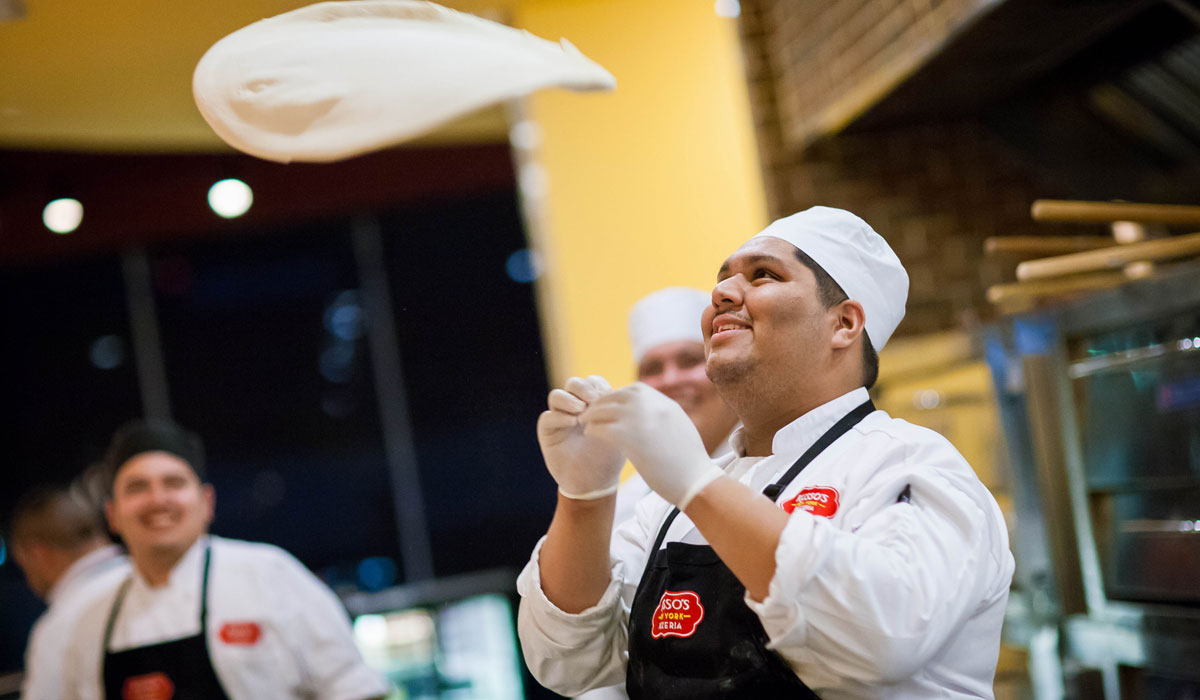Anthony Russo’s parents, first-generation Italian immigrants, weren’t surprised when he suggested he’d run a restaurant for a living. Since turning 12, Russo perfected family recipes from Naples and Sicily as he worked the kitchen of Russo’s Italian Restaurant, a popular local spot his father opened in 1978 after the family moved from New Jersey to Galveston, Texas. But if Russo was going to set out solo, he wasn’t getting any money.
“I went to 20 different banks and got lucky,” Russo says.
He was able to borrow $50,000 and buy a dough mixer, pizza oven, walk-in cooler, and debut two-table Russo’s Pizza in the early 1980s. It was 800 square feet and sat eight people.
A few years later, Russo created Anthony’s Pizzeria, in Clear Lake, Texas, and then moved to Houston.
This year marks three decades since that “little pizza place” started Russo’s journey. His now-56-unit franchise inked deals for more than 15 locations over the past year and plans eight openings for 2022.
Russo shares a story he believes illustrates what’s coming next. As a teenager, Randy McCoy worked in the back of the house at the original Russo’s. It was his first gig. Along with his brother, McCoy helped Russo prepare ingredients and send product out the door. He passed out flyers; hand-shredded blocks of Mozzarella; and made “gallons and gallons” of marinara.
McCoy would go on to manage restaurants in Galveston, take ownership of an underperforming pizza franchise, and, eventually, open a smoothie store along with his wife, Ayesha. After the couple sold the business, McCoy called Russo.
“I guess I made an impact,” Russo says. “That was 30 years ago, but now he’s back.”
McCoy signed on to open five Texas units in June. Why he returned, Russo says, is because the brand didn’t drift over the years, at least where it mattered most. McCoy’s first pizza franchise received product pre-boxed and frozen. Russo’s still makes dishes from scratch, which is one reason it rebranded to Russo’s New York Pizzeria and Italian Kitchen three years ago. It’s a name that reflects a Russo is still calling the shots, and the fact it’s a chef-driven franchise not trying to send foldable pizza to guests as fast as possible. Chicken parmesan, lasagna, baked ziti, fettuccine Alfredo, and other classics are strong menu mix contributors. There are gluten-free items and vegan as well. “We kind of attract a little bit of everybody in the customer base,” Russo says.
Stores place homemade dough in Baker’s Pride and Woodstone deck ovens and Russo brings ingredients back from Italy, where he personally strikes deals with overseas vendors, like olive oil farms. Russo’s requires franchisees train up to six weeks at its home base. Broadly, recipes are the same as they were 30 years ago, from spice mixes to the staples.
“There’s a lot of players out there,” Russo says. “But most of those don’t make stuff in-house anymore.”
“It’s not your real go-to pizza place like in the old days,” he adds of competitors. “They’ve got a pizza sauce coming out of a box. Frozen dough balls. They’re buying products that are already made easy, and I get it—it saves them on labor and makes them more efficient in the kitchen. But the quality is not going to be the same.”
In turn, he’s not worried about “those giants” when it comes to jostling for pizza share; it’s simply a different conversation. Russo’s stores have open kitchens and guests watch dough being made from scratch. “That speaks for itself,” Russo says.
Of Russo’s 56 units, seven are corporate. Average-unit volumes today run in the $1.1–$1.2 million range.
And despite recent supply hurdles, food costs are as low as 20–21 percent because Russo’s doesn’t have a commissary or copacker, he says, which would make the brand pay higher margins. Average net income is 19.2 percent and labor costs 27 percent—a number he tries to soften by teaching operators how to cook efficiently and with large amounts of ingredients. An example he gives: producing five trays of lasagna simultaneously, which can serve 28 people.
The ingredient-centric approach has helped Russo’s grow overseas, too. There’s roughly eight units between Dubai and Saudi Arabia, and Russo will soon exhibit the brand at a franchise show in London. “We’re going to bring it,” he says. “There’s bad pizza in those marketplaces. Since we took our products overseas—our cheese, our flour, our sauce—they get to taste what real pizza tastes like.”
Yet while Russo’s quality-driven ethos isn’t shakable, the chain has become more agile with store models and technology. There are units as small as 800 square feet. Franchisees can open full- or quick-service locations, getting up to 3,500 square feet on the sit-down side.
The brand aligned with Toast as well to develop a point of sale that takes online ordering into the hub. And with delivery, Russo’s fields its own drivers. During COVID, he says, the brand balanced dine-in declines with bundle meals, which “sold, sold, sold, sold.”
Russo says the chain expects to ramp up California growth in the coming year—a market it hasn’t scaled before. It’s also circling Arizona and Tennessee, where you can’t get New York style pizza.”
Russo told the Phoenix Business Journal the brand could have 10–15 restaurants in the Phoenix area over the next few years, and is already looking into Glendale and Tempe real estate.
Meanwhile, it will continue to grow “aggressively” in Russo’s Texas backyard. “There’s a lot of suburbs. A lot of people moving into Texas from other states,” Russo says.
He feels 50–60 new locations in the near future is a tangible possibility, with a goal to get over 100 before long.
“We feel like this year is going to be a really good year for us,” Russo says. “As long as we make sure we make pizza in-house, and quality food, it’s going to separate us from anybody else.”


